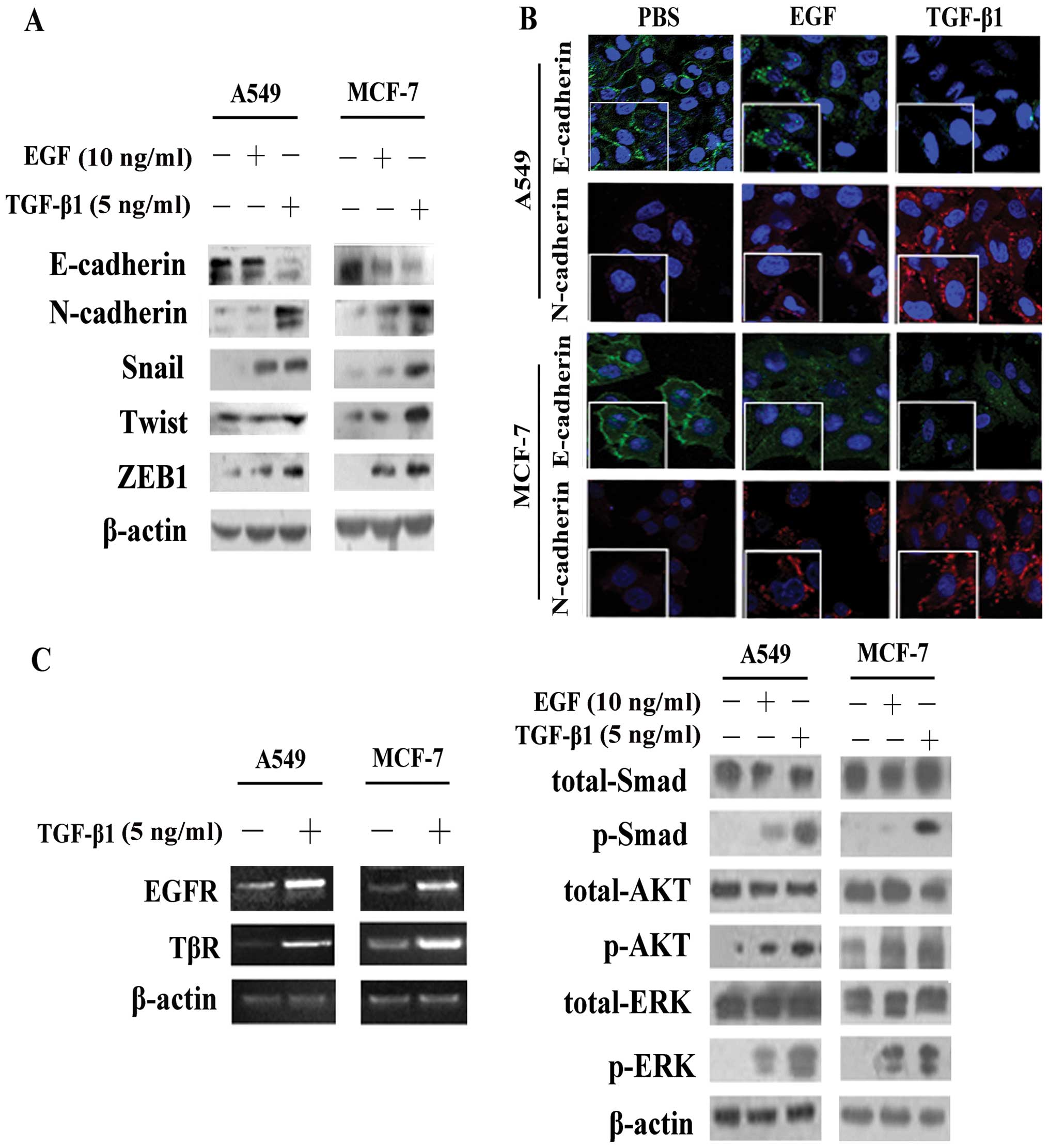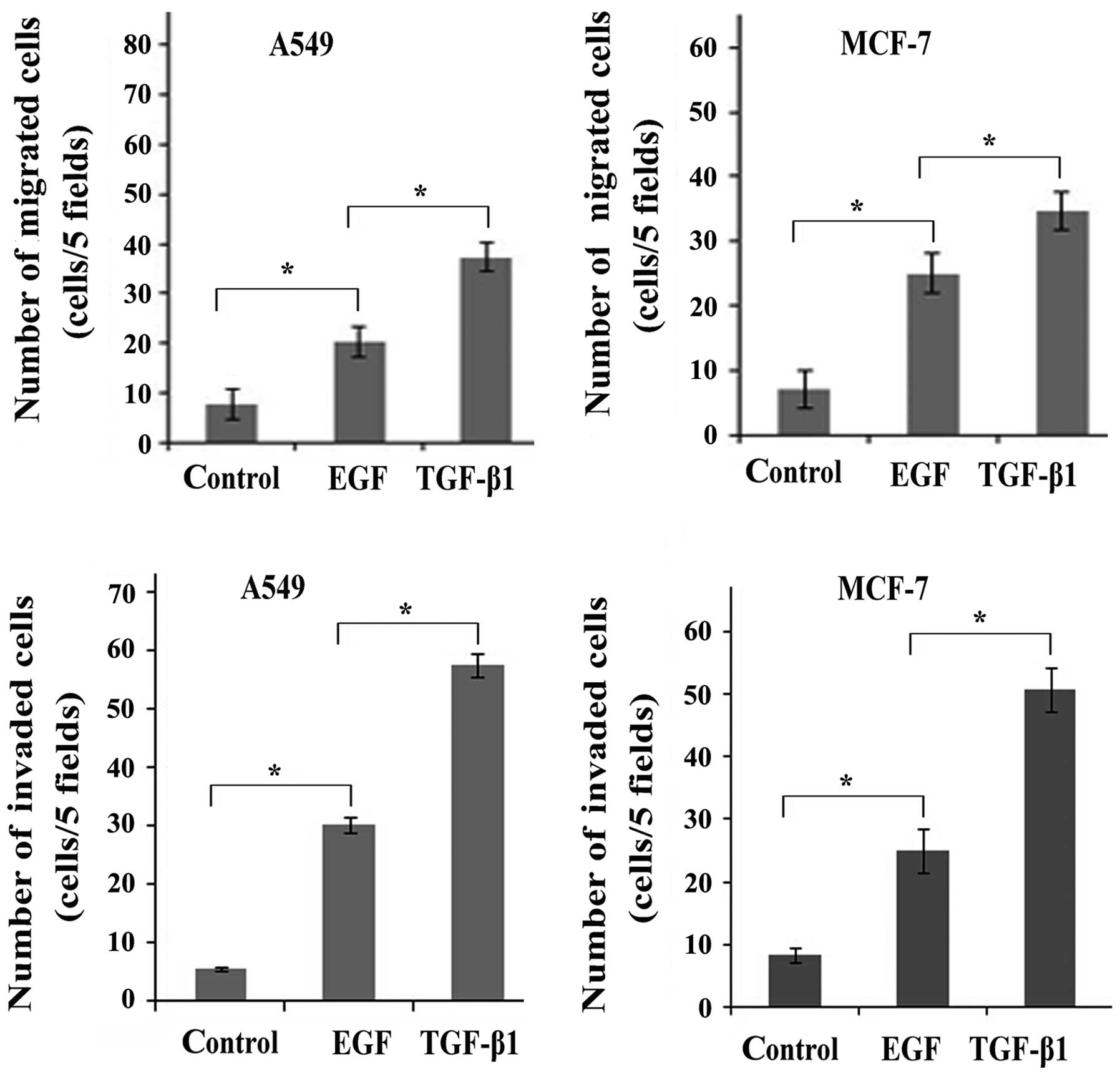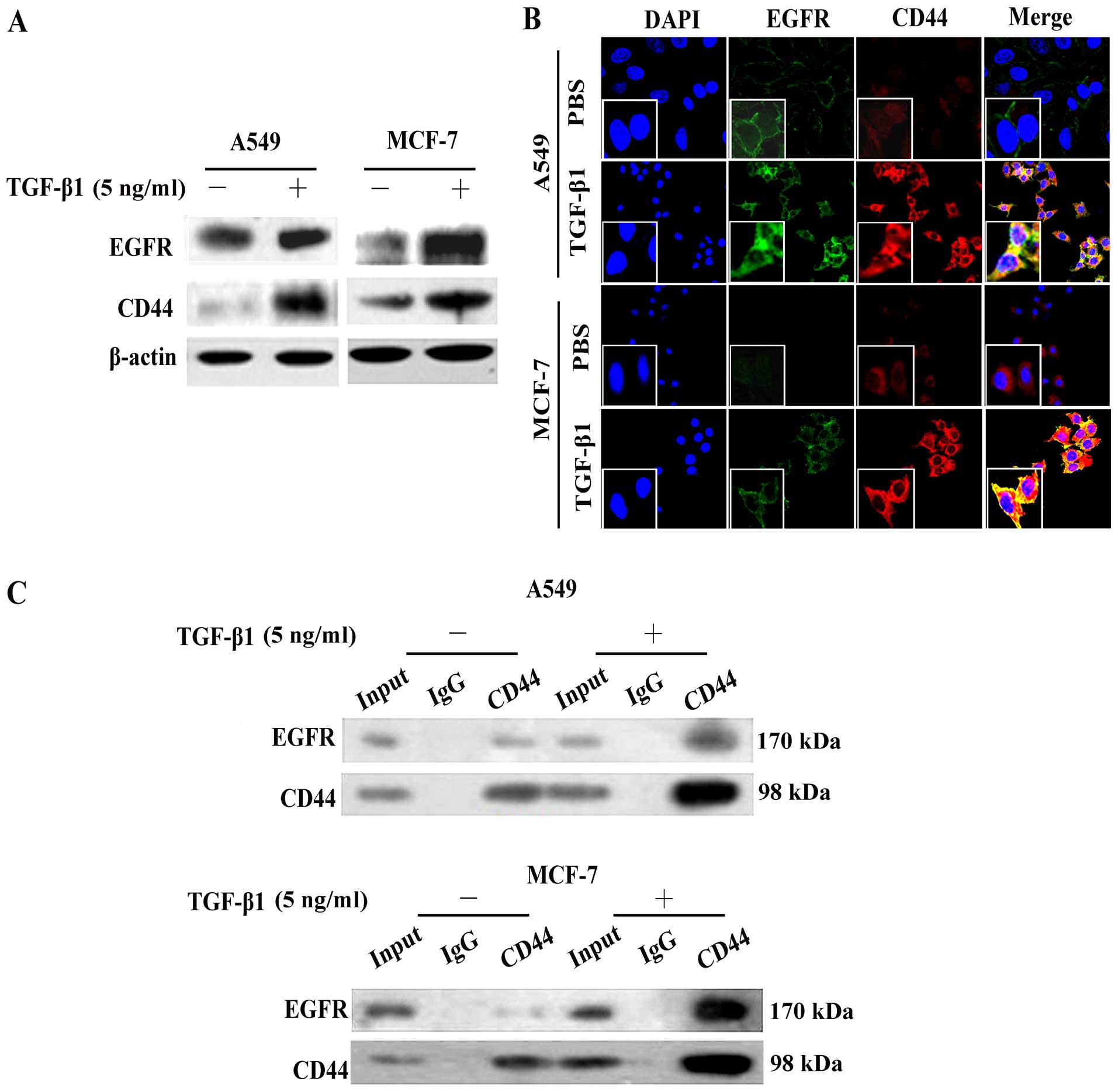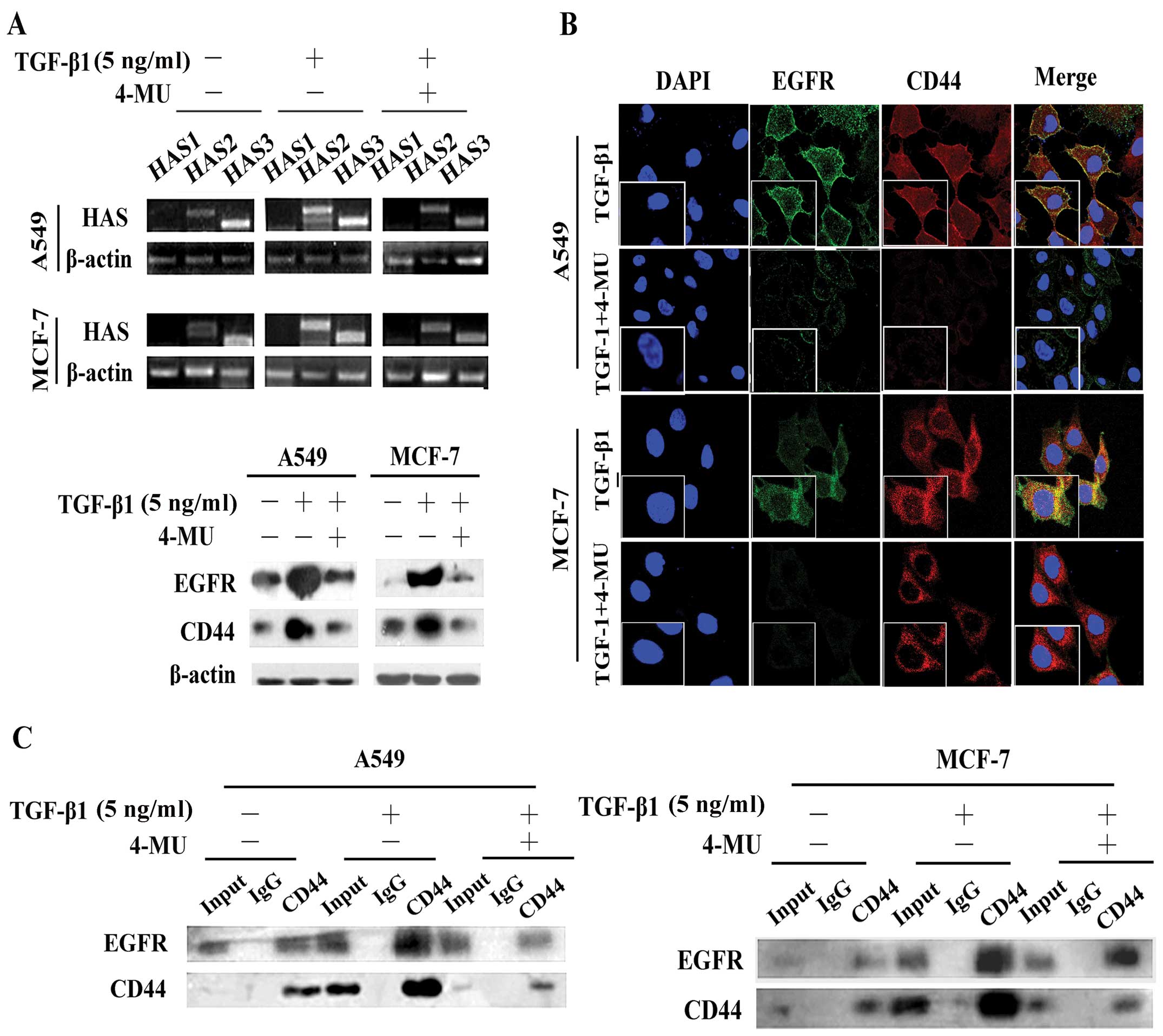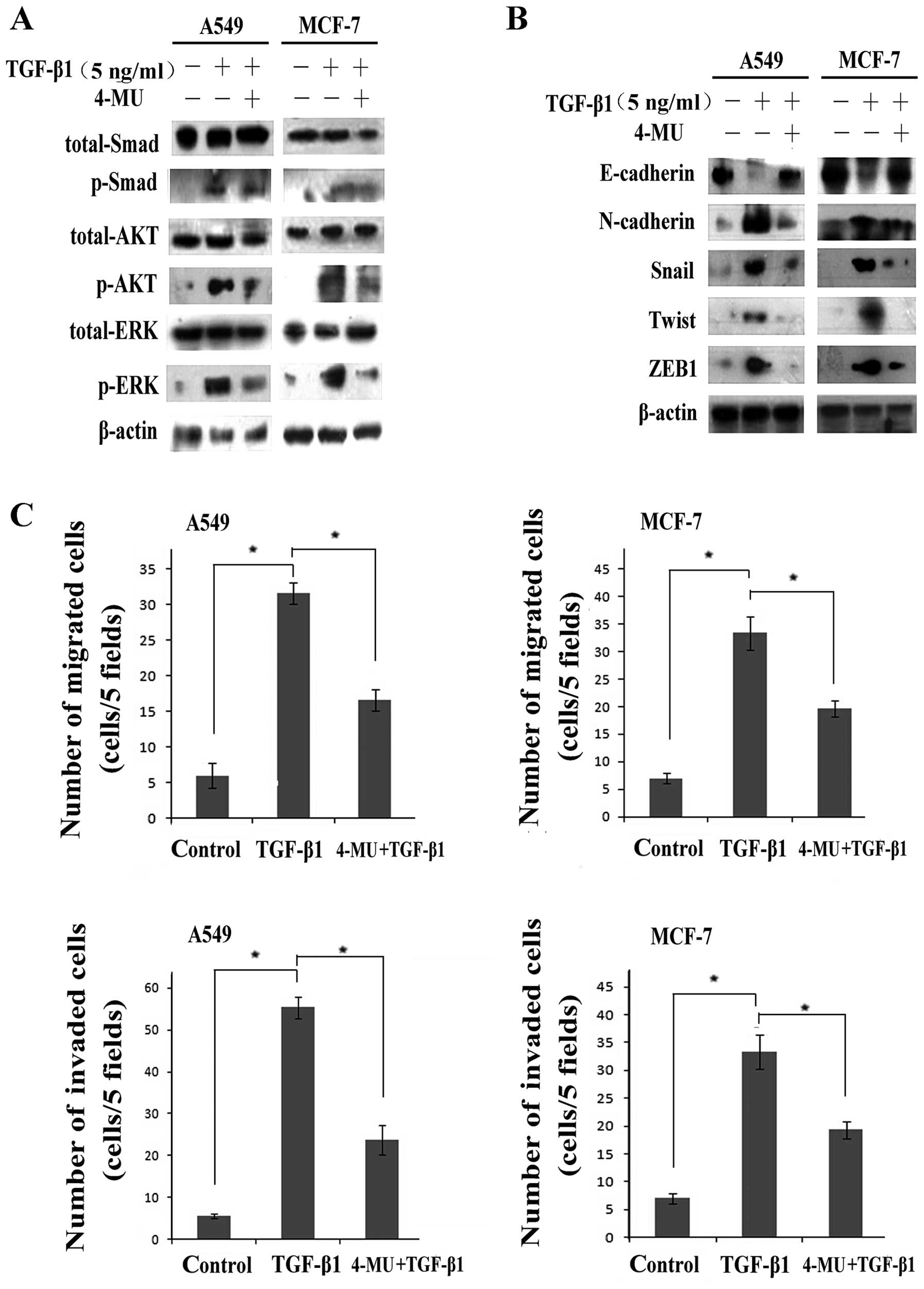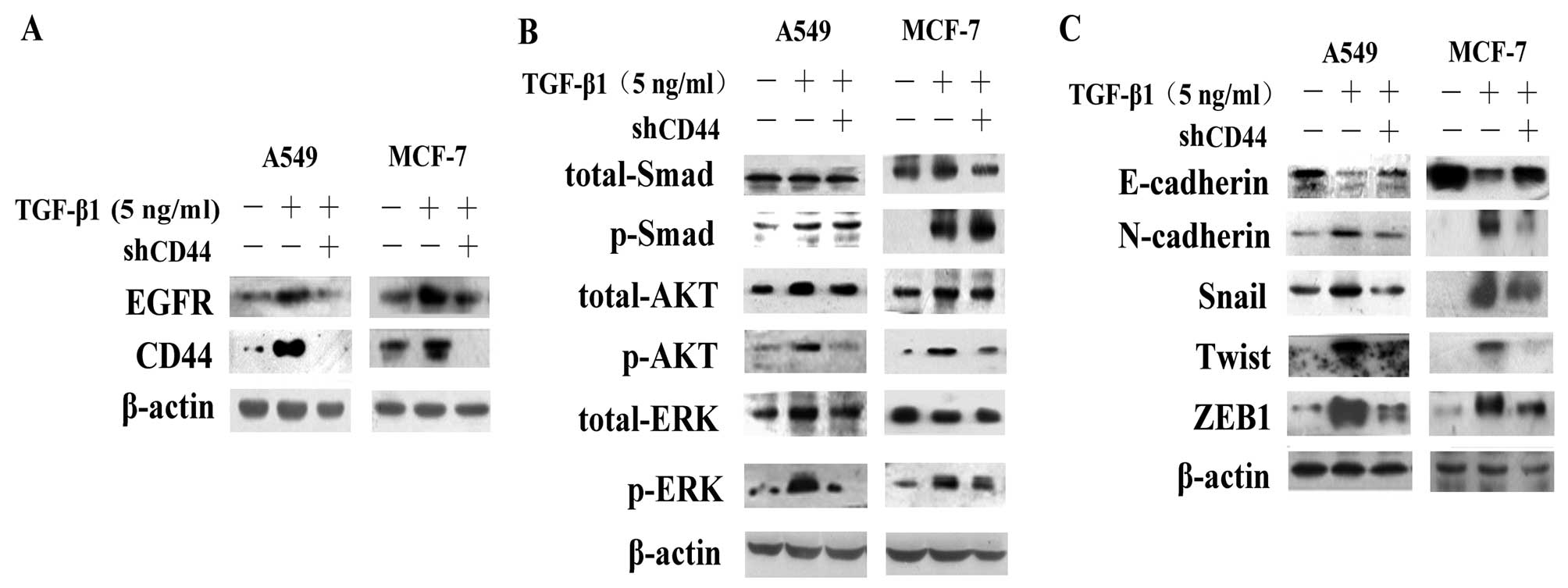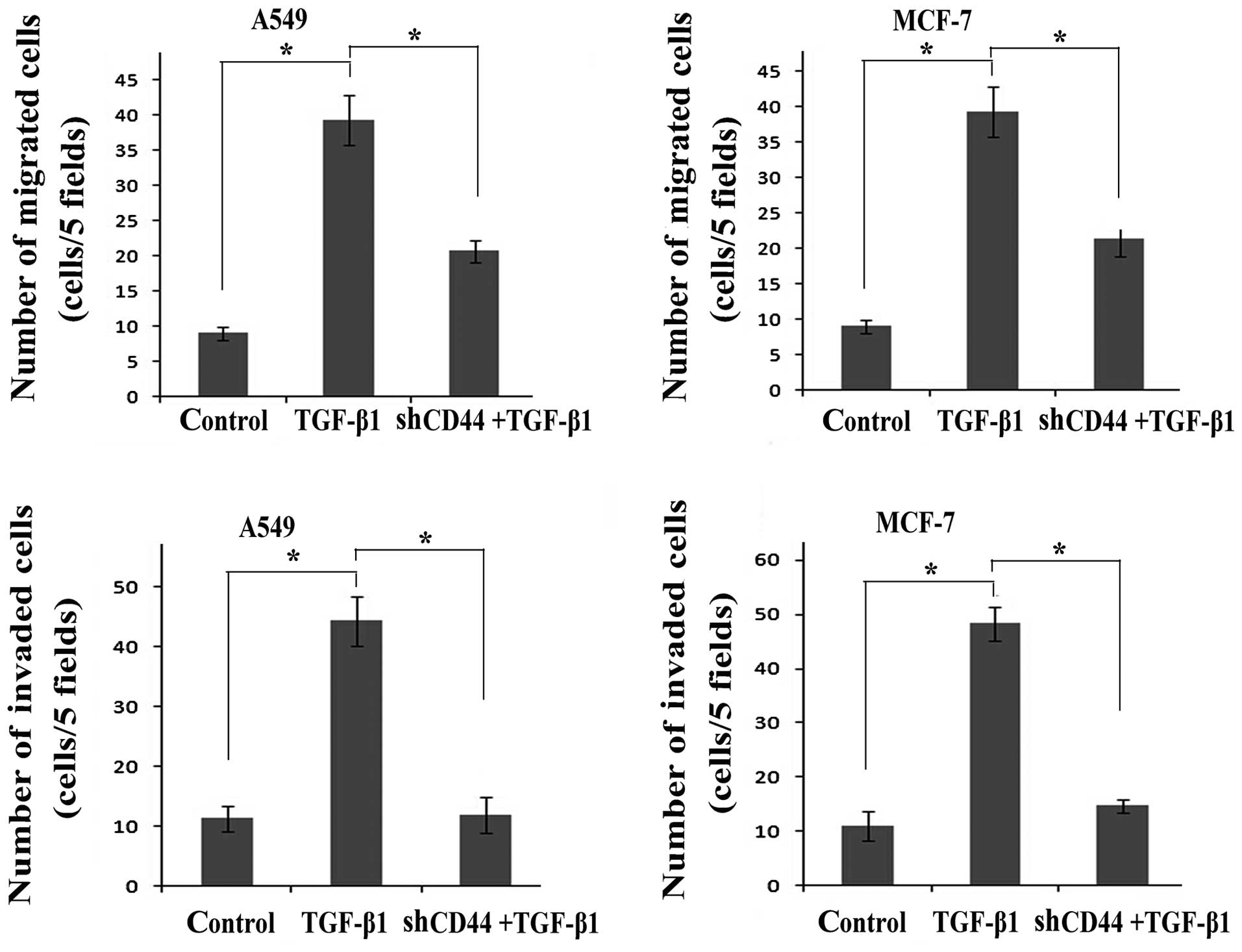|
1
|
Wang Y and Shang Y: Epigenetic control of
epithelial-to-mesenchymal transition and cancer metastasis. Exp
Cell Res. 319:160–169. 2013. View Article : Google Scholar
|
|
2
|
Frisch SM, Schaller M and Cieply B:
Mechanisms that link the oncogenic epithelial-mesenchymal
transition to suppression of anoikis. J Cell Sci. 126:21–29. 2013.
View Article : Google Scholar : PubMed/NCBI
|
|
3
|
Peng Z, Wang CX, Fang EH, Wang GB and Tong
Q: Role of epithelial-mesenchymal transition in gastric cancer
initiation and progression. World J Gastroenterol. 20:5403–5410.
2014. View Article : Google Scholar : PubMed/NCBI
|
|
4
|
Quan J, Elhousiny M, Johnson NW and Gao J:
Transforming growth factor-β1 treatment of oral cancer induces
epithelial-mesenchymal transition and promotes bone invasion via
enhanced activity of osteoclasts. Clin Exp Metastasis. 30:659–670.
2013. View Article : Google Scholar : PubMed/NCBI
|
|
5
|
Sengupta S, Jana S, Biswas S, Mandal PK
and Bhattacharyya A: Cooperative involvement of NFAT and SnoN
mediates transforming growth factor-β (TGF-β) induced EMT in
metastatic breast cancer (MDA-MB 231) cells. Clin Exp Metastasis.
30:1019–1031. 2013. View Article : Google Scholar : PubMed/NCBI
|
|
6
|
Argast GM, Krueger JS, Thomson S,
Sujka-Kwok I, Carey K, Silva S, O’Connor M, Mercado P, Mulford IJ,
Young GD, et al: Inducible expression of TGFβ, snail and Zeb1
recapitulates EMT in vitro and in vivo in a NSCLC model. Clin Exp
Metastasis. 28:593–614. 2011. View Article : Google Scholar : PubMed/NCBI
|
|
7
|
Toda S, Matsumura S, Fujitani N, Nishimura
T, Yonemitsu N and Sugihara H: Transforming growth factor-β1
induces a mesenchyme-like cell shape without epithelial
polarization in thyrocytes and inhibits thyroid folliculogenesis in
collagen gel culture. Endocrinology. 138:5561–5575. 1997.PubMed/NCBI
|
|
8
|
Richter P, Umbreit C, Franz M and Berndt
A, Grimm S, Uecker A, Böhmer FD, Kosmehl H and Berndt A: EGF/TGFβ1
co-stimulation of oral squamous cell carcinoma cells causes an
epithelial-mesenchymal transition cell phenotype expressing laminin
332. J Oral Pathol Med. 40:46–54. 2011. View Article : Google Scholar
|
|
9
|
Liu Z, Du R, Long J, Dong A, Fan J, Guo K
and Xu Y: JDP2 inhibits the epithelial-to-mesenchymal transition in
pancreatic cancer BxPC3 cells. Tumour Biol. 33:1527–1534. 2012.
View Article : Google Scholar : PubMed/NCBI
|
|
10
|
Chen J, Wang T, Zhou YC, Gao F, Zhang ZH,
Xu H, Wang SL and Shen LZ: Aquaporin 3 promotes
epithelial-mesenchymal transition in gastric cancer. J Exp Clin
Cancer Res. 33:382014. View Article : Google Scholar : PubMed/NCBI
|
|
11
|
Li L, Han R, Xiao H, Lin C, Wang Y, Liu H,
Li K, Chen H, Sun F, Yang Z, et al: Metformin sensitizes
EGFR-TKI-resistant human lung cancer cells in vitro and in vivo
through inhibition of IL-6 signaling and EMT reversal. Clin Cancer
Res. 20:2714–2726. 2014. View Article : Google Scholar : PubMed/NCBI
|
|
12
|
Davis FM, Peters AA, Grice DM, Cabot PJ,
Parat MO, Roberts-Thomson SJ and Monteith GR: Non-stimulated,
agonist-stimulated and store-operated Ca2+ influx in MDA-MB-468
breast cancer cells and the effect of EGF-induced EMT on calcium
entry. PLoS One. 7:e369232012. View Article : Google Scholar : PubMed/NCBI
|
|
13
|
Berndt A, Büttner R, Gühne S, Gleinig A,
Richter P, Chen Y, Franz M and Liebmann C: Effects of activated
fibroblasts on phenotype modulation, EGFR signalling and cell cycle
regulation in OSCC cells. Exp Cell Res. 322:402–414. 2014.
View Article : Google Scholar : PubMed/NCBI
|
|
14
|
Ren S, Su C, Wang Z, et al: Epithelial
phenotype as a predictive marker for response to EGFR-TKIs in
non-small cell lung cancer patients with wild-type EGFR. Int J
Cancer. 135:2962–2971. 2014. View Article : Google Scholar : PubMed/NCBI
|
|
15
|
Tian YC, Chen YC, Chang CT, Hung CC, Wu
MS, Phillips A and Yang CW: Epidermal growth factor and
transforming growth factor-beta1 enhance HK-2 cell migration
through a synergistic increase of matrix metalloproteinase and
sustained activation of ERK signaling pathway. Exp Cell Res.
313:2367–2377. 2007. View Article : Google Scholar : PubMed/NCBI
|
|
16
|
Ouyang H, Gore J, Deitz S and Korc M:
microRNA-10b enhances pancreatic cancer cell invasion by
suppressing TIP30 expression and promoting EGF and TGF-β actions.
Oncogene. 33:4664–4674. 2014. View Article : Google Scholar :
|
|
17
|
Chow G, Tauler J and Mulshine JL:
Cytokines and growth factors stimulate hyaluronan production: role
of hyaluronan in epithelial to mesenchymal-like transition in
non-small cell lung cancer. J Biomed Biotechnol. 2010:4854682010.
View Article : Google Scholar : PubMed/NCBI
|
|
18
|
Porsch H, Bernert B, Mehić M, Theocharis
AD, Heldin CH and Heldin P: Efficient TGFβ-induced
epithelial-mesenchymal transition depends on hyaluronan synthase
HAS2. Oncogene. 32:4355–4365. 2013. View Article : Google Scholar :
|
|
19
|
Hiscox S, Baruha B, Smith C, Bellerby R,
Goddard L, Jordan N, Poghosyan Z, Nicholson RI, Barrett-Lee P and
Gee J: Overexpression of CD44 accompanies acquired tamoxifen
resistance in MCF7 cells and augments their sensitivity to the
stromal factors, heregulin and hyaluronan. BMC Cancer. 12:4582012.
View Article : Google Scholar : PubMed/NCBI
|
|
20
|
Goodison S, Urquidi V and Tarin D: CD44
cell adhesion molecules. Mol Pathol. 52:189–196. 1999. View Article : Google Scholar
|
|
21
|
Hiraga T, Ito S and Nakamura H: Cancer
stem-like cell marker CD44 promotes bone metastases by enhancing
tumorigenicity, cell motility, and hyaluronan production. Cancer
Res. 73:4112–4122. 2013. View Article : Google Scholar : PubMed/NCBI
|
|
22
|
Midgley AC, Bowen T, Phillips AO and
Steadman R: MicroRNA-7 inhibition rescues age-associated loss of
EGF receptor and hyaluronan (HA)-dependent differentiation in
fibroblasts. Aging Cell. 13:235–244. 2013. View Article : Google Scholar
|
|
23
|
Williams K, Motiani K, Giridhar PV and
Kasper S: CD44 integrates signaling in normal stem cell, cancer
stem cell and (pre) metastatic niches. Exp Biol Med (Maywood).
238:324–338. 2013. View Article : Google Scholar
|
|
24
|
Xu Z, Jiang Y, Steed H, Davidge S and Fu
Y: TGFβ and EGF synergistically induce a more invasive phenotype of
epithelial ovarian cancer cells. Biochem Biophys Res Commun.
401:376–381. 2010. View Article : Google Scholar : PubMed/NCBI
|
|
25
|
Wendt MK, Smith JA and Schiemann WP:
Transforming growth factor-β-induced epithelial-mesenchymal
transition facilitates epidermal growth factor-dependent breast
cancer progression. Oncogene. 29:6485–6498. 2010. View Article : Google Scholar : PubMed/NCBI
|
|
26
|
Ohshio Y, Teramoto K, Hashimoto M,
Kitamura S, Hanaoka J and Kontani K: Inhibition of transforming
growth factor-β release from tumor cells reduces their motility
associated with epithelial-mesenchymal transition. Oncol Rep.
30:1000–1006. 2013.PubMed/NCBI
|
|
27
|
Elloul S, Kedrin D, Knoblauch NW, Beck AH
and Toker A: The adherens junction protein afadin is an AKT
substrate that regulates breast cancer cell migration. Mol Cancer
Res. 12:464–476. 2014. View Article : Google Scholar :
|
|
28
|
Voon DC, Wang H, Koo JK, Chai JH, Hor YT,
Tan TZ, Chu YS, Mori S and Ito Y: EMT-induced stemness and
tumorigenicity are fueled by the EGFR/Ras pathway. PLoS One.
8:e704272013. View Article : Google Scholar : PubMed/NCBI
|
|
29
|
Buonato JM and Lazzara MJ: ERK1/2 blockade
prevents epithelial-mesenchymal transition in lung cancer cells and
promotes their sensitivity to EGFR inhibition. Cancer Res.
74:309–319. 2014. View Article : Google Scholar :
|
|
30
|
Kang M, Choi S, Jeong SJ, Lee SA, Kwak TK,
Kim H, Jung O, Lee MS, Ko Y, Ryu J, et al: Cross-talk between TGFβ1
and EGFR signalling pathways induces TM4SF5 expression and
epithelial-mesenchymal transition. Biochem J. 443:691–700. 2012.
View Article : Google Scholar : PubMed/NCBI
|
|
31
|
Heffler M, Golubovskaya VM, Conroy J, Liu
S, Wang D, Cance WG and Dunn KB: FAK and HAS inhibition
synergistically decrease colon cancer cell viability and affect
expression of critical genes. Anticancer Agents Med Chem.
13:584–594. 2013. View Article : Google Scholar :
|
|
32
|
Su CY, Li YS, Han Y, Zhou SJ and Liu ZD:
Correlation between expression of cell adhesion molecules CD44 v6
and E-cadherin and lymphatic metastasis in non- small cell lung
cancer. Asian Pac J Cancer Prev. 15:2221–2224. 2014. View Article : Google Scholar
|
|
33
|
Cheng C, Yaffe MB and Sharp PA: A positive
feedback loop couples Ras activation and CD44 alternative splicing.
Genes Dev. 20:1715–1720. 2006. View Article : Google Scholar : PubMed/NCBI
|
|
34
|
Raso-Barnett L, Banky B, Barbai T, Becsagh
P, Timar J and Raso E: Demonstration of a melanoma-specific CD44
alternative splicing pattern that remains qualitatively stable, but
shows quantitative changes during tumour progression. PLoS One.
8:e538832013. View Article : Google Scholar : PubMed/NCBI
|
|
35
|
Perez A, Neskey DM, Wen J, Pereira L,
Reategui EP, Goodwin WJ, Carraway KL and Franzmann EJ: CD44
interacts with EGFR and promotes head and neck squamous cell
carcinoma initiation and progression. Oral Oncol. 49:306–313. 2013.
View Article : Google Scholar :
|
|
36
|
Grass GD, Tolliver LB, Bratoeva M and
Toole BP: CD147, CD44, and the epidermal growth factor receptor
(EGFR) signaling pathway cooperate to regulate breast epithelial
cell invasiveness. J Biol Chem. 288:26089–26104. 2013. View Article : Google Scholar : PubMed/NCBI
|
|
37
|
Midgley AC, Rogers M, Hallett MB, Clayton
A, Bowen T, Phillips AO and Steadman R: Transforming growth
factor-β1 (TGF-β1)-stimulated fibroblast to myofibroblast
differentiation is mediated by hyaluronan (HA)-facilitated
epidermal growth factor receptor (EGFR) and CD44 co-localization in
lipid rafts. J Biol Chem. 288:14824–14838. 2013. View Article : Google Scholar : PubMed/NCBI
|















